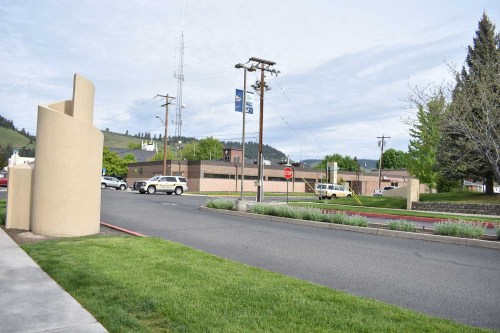Higher education report shows overall improvements, some COVID setbacks
Published 10:00 am Saturday, November 12, 2022

- A Union County Sheriff’s Office vehicle passes by Eastern Oregon University’s campus on Friday, May 27, 2022.
SALEM — Oregon has made progress toward reaching a state goal that 80% of young people attain some kind of postsecondary credential, according to a new report from the state’s Higher Education Coordinating Commission. But a pandemic setback in college-going and college-completion rates could hamper that progress if they continue long-term.
Despite overall gains, detailed data through 2021 shows that progress varied across racial and ethnic groups, and that some disparities have actually grown wider over time. Gaps in earnings after college, for example, have widened between some demographic groups in the last several years.
Trending
“That’s an important finding,” Amy Cox, research and data director for the commission, said about earnings data at a commission meeting Thursday, Nov. 10. “What it says is that the benefits of postsecondary education and training continued to not be evenly or equitably experienced across all groups.”
Cox’s report to the commission covered several measures the state agency tracks across the K-12 and higher education spectrum, including the college-going rate, postsecondary completion rate and post-college earnings. The measures are an indication of the state’s progress toward its so-called 40-40-20 goal for 40% of students to attain a bachelor’s degree or higher, 40% to obtain a college certificate or associate degree and 20% to obtain at least a high school diploma.
After several years of somewhat stagnant outcomes, the 2021 data show a slight improvement in bachelor’s degree attainment. Some 38% of 25- to 34 -year-olds in Oregon had earned a bachelor’s degree in 2021, Cox’s data showed, compared to 36% the year before.
“I think there is some good news story here,” Cox said.
College-going drops
As The Oregonian/OregonLive has previously reported, college-going rates plummeted among the class of 2020, who graduated at the onset of the pandemic and were faced with the prospect of starting college in a virtual setting.
Trending
Just 56% of the class of 2020 enrolled in college within 16 months, down from 63% of the class of 2019.
“The rate of decline is pretty dramatic,” Cox told commissioners.
Nearly all racial and ethnic groups saw this sharp drop during the pandemic, the commission’s data shows, but the long-term trends vary. Overall college-going rates have fallen about 9 percentage points since 2011, Cox’s data shows. College-going among Native American students has dropped most severely by 17 percentage points since 2011. The college-going rate for Latino students had been slowly rising since 2011, but the pandemic wiped out that progress.
The drop in the percentage of high school graduates entering college could be a temporary blip, and longer-term data will show if 2020 graduates did eventually enroll after taking time away from school.
That outcome will factor into Oregon’s progress toward 40-40-20 goals.
“If the recent decline in college-going rate is a pandemic anomaly, then continued slow growth or stability in education attainment is likely,” Cox’s report said. “If the decline in college-going remains, the share of the young adult population with a postsecondary credential is likely to fall in the coming years.”
College completion mixed
Community college and university completion and graduation rates have risen over time. But recent data shows the pandemic impacted them in slightly different ways.
Community college completion and transfer rates fell slightly during the pandemic, the first decline in eight years, Cox said. Graduation rates at the state’s public universities, however, continued to rise.
Detailed racial and ethnic data paints a more complicated picture of whether colleges are addressing disparate outcomes between student groups.
At the community college level, the percentage of Black students, Latino students and Native American students finishing college has risen more over time than the percentage of white students finishing college, helping narrow the equity gap with white students, who still complete their degrees at a higher rate. In order to close those equity gaps, Cox said, improvement among underserved student groups needs to rise faster.
At public universities, despite an overall increase in graduation rates, some underserved students have fallen further behind.
“Graduation rates continue to rise even into the pandemic, but the equity gaps don’t appear to be closing, at least not for all groups,” Cox said.
The share of Black students, Native Hawaiian students and Native American students completing their degree within six years fell between the entering class of 2006 and 2015, state data shows. Outcomes for these student groups can vary widely from year to year because of small student numbers, Cox noted.
Latino students’ graduation rates are a noteworthy exception. Some 64% of Latino students who started at a university in 2015 graduated within six years, nearly approaching the state average of 68%. That graduation rate was closer to 52% for Latino students who started school in 2006.
Enrollment of students who identify as Latino has also shot up during that timeframe, Cox told commissioners, and that increased presence on campus, along with institutional efforts, has probably helped drive graduation rates up.
“I’m excited to see the continued investments from institutions and the state on increasing the culture and environment for Latino communities and other BIPOC communities,” commissioner Ricardo Lujan-Valerio said. “Trends will just improve as we see those changes happen in higher education.”
Wages rise disproportionately
Higher education credentials help boost wages. According to a separate report from the commission, median earnings for students with graduate, bachelor’s, associate degrees and career certificates all outpaced the state’s median wage in 2019. Students who did not earn a credential after high school were still making below the median wage, ten years out of high school.
Wages earned by community college completers and university graduates have both improved over time, Cox told the commission, a net positive for the state’s goal of seeing wages rise.
Racial and ethnic earning gaps have been closing over time among students who receive community college credentials, state data shows. But that’s not the case for bachelor’s degree earners.
Five years out of school, racial income disparities are worse between graduates in the class of 2015 than they were for graduates in the class of 2006, commission data shows.
While most student groups still saw incomes rise between 2011 and 2020, Black university graduates saw a 10% earnings drop over that time period, state data shows.









